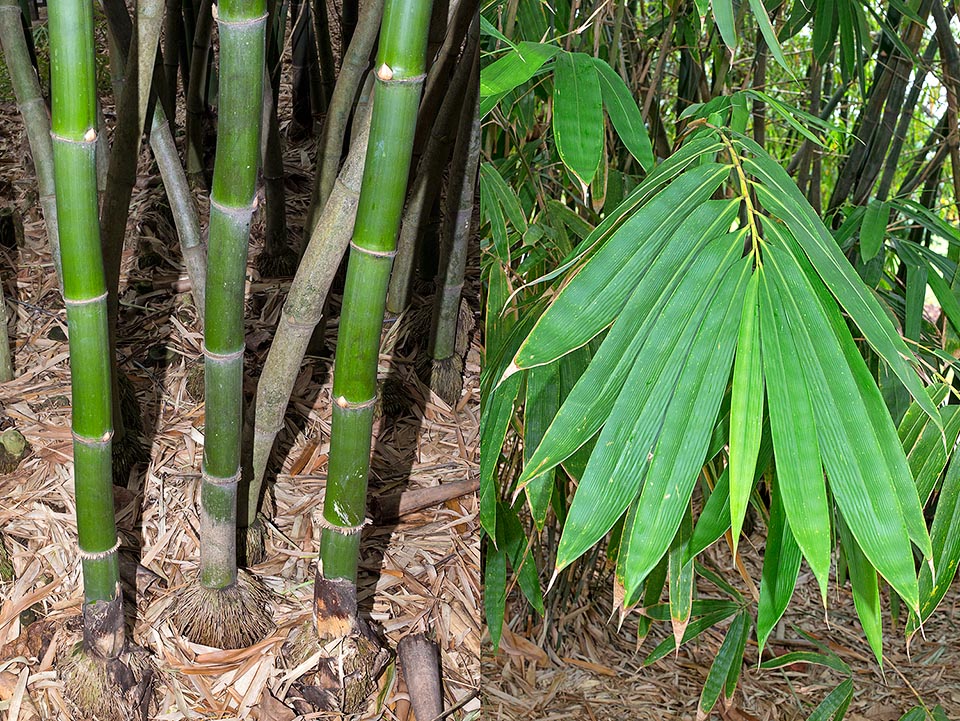Family : Poaceae

Text © Pietro Puccio

English translation by Mario Beltramini

Native to China, Java and Lesser Sunda Islands, Gigantochloa agtroviolacea is one of the most ornamental bamboos due to the blackish violet culms, curved at the apex, even 15 m tall with luxuriant foliage © Giuseppe Mazza
The name of the genus is the combination of the Greek substantives “γίγας, -αντος” (gigas, -antos) = giant and “χλόη” (chloe) = grass, with obvious reference; the specific name is the combination of the Latin adjectives “ater, atra, atrum” = black, dark and “violaceus, a, um” = violet, violaceous, with reference to the colour the culms assume after some time.
Common names: black bamboo, Java black bamboo, tropical black bamboo (English); pring wulung, pring ireng (Javanese); bambu hitam (Indonesian); phai dam indonisia (Thai).
The Gigantochloa atroviolacea (1987) is a rhizomatous perennial species, evergreen, that forms rather dense tufts with stems (culms) cylyndrical erect with curved apex, 8-15 m tall and of 6-10 cm of diameter, provided of aerial roots at the nodes closest to the soil; the culms are hollow between the nodes with about 6 mm thick walls.
The internodes, 30-45 cm long, are initially green, then blackish violet, eventually with thin green stripes, on which stand out the whitish nodes.
When young the culms are protected by deciduous triangular bracts, up to 20 cm long, covered by a thick blackish down.
From the nodes, excepting the lowest ones, develop various branches, one of which is predominant, with alternate leaves, oblong-lanceolate with long pointed apex, 20-28 cm long and 2-5 cm broad, of intense green colour.
Undefined inflorescences with sessile spikelets grouped at the nodes bearing 4 fertile flowers and one sterile, sessile.
It reproduces by seed, if available, by division of rhizomes, with each portion provided of at least three culms, but more frequently by stem cutting to be done preferably by the end of the vegetative season, when the plant has stored the maximum of the reserves.
It is utilized a portion of 2-3 years old culm with two or three nodes provided of buds, placed obliquely or vertically on a sandy substratum rich of organic substance maintained humid at the temperature of 24-26 °C.
Of easy cultivation and growth, it is considered as one of the most ornamental bamboos due to the blackish culms and the luxuriant foliage, cultivable in the tropical and subtropical climate regions, its cultivation may be tried in the milder temperate-warm ones where temperatures just under the 0 °C are exceptional events and of limited duration.
It requires a position in full sun or slight shade and is not particular about the soil, provided draining, with preference for the calcareous ones; although being native to zones with high annual rainfall, grows well also on dry and rocky soils moderately irrigated.

The 30-45 cm long internodes are initially green, with aerial roots at the base of the stem. The alternate leaves, of intense green colour, reach the length of 20-28 cm © Giuseppe Mazza
Synonyms: Gigantochloa atter var. nigra Gamble (1896).
→ To appreciate the biodiversity within the POACEAE family please click here.
